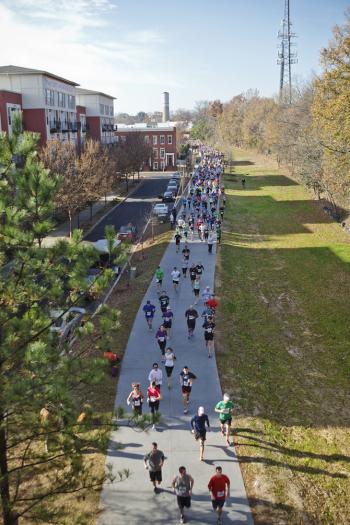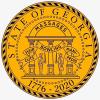Learn from Atlanta?
Pub Notes

Photo Credit: Christopher T. Martin
The Inaugural Atlanta BeltLine Southeast 8K Runwalk took off in September.
Paul F. Morris, CEO of Atlanta BeltLine, Inc., spoke at the College of Environment and Design on campus last week about the massive project that is transforming the Atlanta that we know and hate. Morris is a tall, trim fellow with 30 years of experience in all aspects of urban design all over the country and out of it, and he stood and talked to a packed auditorium (some student attendance suggested) without notes for well over an hour. The scope of the BeltLine project is staggering, both that somebody could have thought it up and even more so that a city which is the very embodiment of automobile-dependence (except when it snows) is actually involved in the process of making this audacious plan work.
Briefly, back around the turn of the last century, a Georgia Tech graduate student wrote his thesis on the possibilities for converting a 22-mile abandoned rail route into a bicycle, pedestrian, parks and transit loop connecting Atlanta’s intown neighborhoods. The old, circular rail route was constructed for deliveries to businesses and manufacturing plants and fell into disuse as trucks replaced its function. But the routes and right-of-ways are still there, and that Tech student, Ryan Gravel, had the vision to see what it could become and what Atlanta can become. And it’s working. The first two-plus mile segment is open and already getting heavy use. Affordable housing is part of the mix, and restaurants and bars are springing up along the route. The project will cost billions, but Atlanta is financing it through tax allocation districts that pull in the revenue generated by all the business and housing improvements to what had been under-utilized land. The BeltLine is truly an example of “build it, and they will come.” Atlanta is building it, and they are coming—to walk, bike, run, stroll, picnic, live, eat and drink. The Atlanta BeltLine is no longer a thesis; it is reality; it is the tangible future, and it is all the more amazing, because it represents such a dramatic departure from Atlanta’s auto-centric allegiance.
We have our own possibilities here in Athens. Read Dr. Jack Crowley’s current installment on our downtown master plan on p. 9 in this issue. He lays out a breathtaking compendium of connectivity that shows how, using our own rail and road corridors, we have all kinds of possibilities for routes that allow people to move around our downtown area and beyond on foot and on bikes.
We have the infrastructure. The question is, do we have the will? Do we have the vision? Do we have the understanding of the civic and economic benefits waiting for us if we can muster the nerve to latch on now to developments that are within our grasp and that are proven to work because they are what people want?
Is a pedestrian-and-bike-friendly environment what our people want, or do our people just want to stay in their automobiles and drive everywhere? That’s certainly what our mayor and most of our commission and our city management want, but they will change if they can be convinced that a sizable number of our people want to be freed from dependence on the automobile.
So far, all our people have seen is a greenway almost completely set up for recreation, and bike riding, for the most part, on dangerous, crowded, hilly streets. But we have infrastructure already in place to do a lot more. If somebody in our local government can focus on our interconnectivity not dependent on the automobile, we have, as Crowley indicates, rich possibilities in town and on campus for opening Athens up to sustainable travel and development.
As Atlanta is showing us, where there’s a will, there’s a way. Athens needs to find the will.
Keywords
More by Pete McCommons
-
Voting Absentee: Necessary But Not Easy
Pub Notes
-

Be Ready When National TV Comes Calling
Pub Notes
-










comments